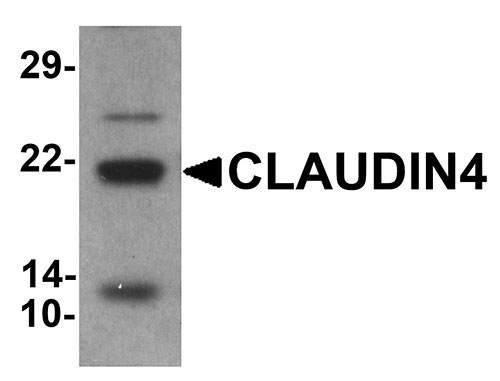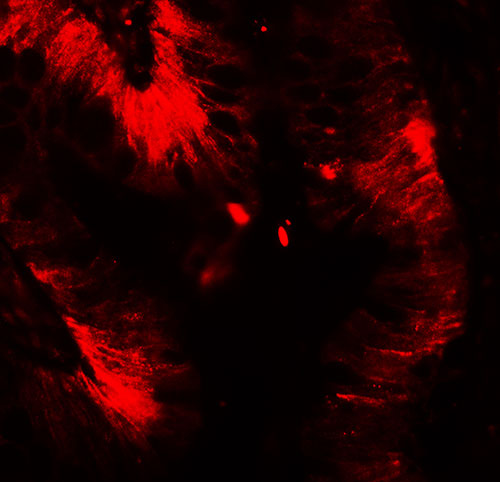CLAUDIN4 Antibody
- SPECIFICATION
- CITATIONS
- PROTOCOLS
- BACKGROUND

Application
| WB, IF, E |
|---|---|
| Primary Accession | O14493 |
| Other Accession | NP_001296, 4502877 |
| Reactivity | Human, Mouse, Rat |
| Host | Rabbit |
| Clonality | Polyclonal |
| Isotype | IgG |
| Calculated MW | 23 kDa |
| Application Notes | CLAUDIN4 antibody can be used for detection of CLAUDIN4 by Western blot at 1 µg/mL. For immunofluorescence start at 20 µg/mL. |
| Gene ID | 1364 |
|---|---|
| Target/Specificity | CLDN4; At least four isoforms of CLAUDIN4 are known to exist; CLAUDIN4 antibody will detect all four isoforms |
| Reconstitution & Storage | CLAUDIN4 antibody can be stored at 4℃ for three months and -20℃, stable for up to one year. As with all antibodies care should be taken to avoid repeated freeze thaw cycles. Antibodies should not be exposed to prolonged high temperatures. |
| Precautions | CLAUDIN4 Antibody is for research use only and not for use in diagnostic or therapeutic procedures. |
| Name | CLDN4 {ECO:0000303|PubMed:35773259, ECO:0000312|HGNC:HGNC:2046} |
|---|---|
| Function | Can associate with other claudins to regulate tight junction structural and functional strand dynamics (PubMed:35773259, PubMed:36008380). May coassemble with CLDN8 into tight junction strands containing anion-selective channels that convey paracellular chloride permeability in renal collecting ducts (By similarity) (PubMed:36008380). May integrate into CLDN3 strands to modulate localized tight junction barrier properties (PubMed:35773259, PubMed:36008380). May disrupt strand assembly of channel-forming CLDN2 and CLDN15 and inhibit cation conductance (PubMed:35773259, PubMed:36008380). Cannot form tight junction strands on its own (PubMed:35773259, PubMed:36008380). |
| Cellular Location | Cell junction, tight junction. Cell membrane; Multi-pass membrane protein |

Thousands of laboratories across the world have published research that depended on the performance of antibodies from Abcepta to advance their research. Check out links to articles that cite our products in major peer-reviewed journals, organized by research category.
info@abcepta.com, and receive a free "I Love Antibodies" mug.
Provided below are standard protocols that you may find useful for product applications.
Background
CLAUDIN4 Antibody: CLAUDIN4 is an integral membrane protein belonging to the claudin family, a family of cellular adhesion molecules that are components of tight junctions. CLAUDIN4 is a component of tight junction strands and may play a role in internal organ development and function during pre- and postnatal life. The CLAUDIN4 gene is deleted in Williams-Beuren syndrome, a neurodevelopmental disorder affecting multiple systems. CLAUDIN4 is frequently overexpressed in ovarian and other epithelial cancers.
References
Mitic LL, Unger VM, and Anderson JM. Expression, solubilization, and biochemical characterization of the tight junction transmembrane protein claudin-4. Protein Sci. 2003; 12:218-27.
Paperna T, Peoples R, Wang YK, et al. Genes for the CPE receptor (CPETR1) and the human homolog of RVP1 (CPETR2) are localized within the Williams-Beuren syndrome deletion. Genomics 1998; 54:453-9.
Morin PJ. Claudin proteins in human cancer: promising new targets for diagnosis and therapy. Cancer Res. 2005; 65:9603-6.
If you have used an Abcepta product and would like to share how it has performed, please click on the "Submit Review" button and provide the requested information. Our staff will examine and post your review and contact you if needed.
If you have any additional inquiries please email technical services at tech@abcepta.com.













 Foundational characteristics of cancer include proliferation, angiogenesis, migration, evasion of apoptosis, and cellular immortality. Find key markers for these cellular processes and antibodies to detect them.
Foundational characteristics of cancer include proliferation, angiogenesis, migration, evasion of apoptosis, and cellular immortality. Find key markers for these cellular processes and antibodies to detect them. The SUMOplot™ Analysis Program predicts and scores sumoylation sites in your protein. SUMOylation is a post-translational modification involved in various cellular processes, such as nuclear-cytosolic transport, transcriptional regulation, apoptosis, protein stability, response to stress, and progression through the cell cycle.
The SUMOplot™ Analysis Program predicts and scores sumoylation sites in your protein. SUMOylation is a post-translational modification involved in various cellular processes, such as nuclear-cytosolic transport, transcriptional regulation, apoptosis, protein stability, response to stress, and progression through the cell cycle. The Autophagy Receptor Motif Plotter predicts and scores autophagy receptor binding sites in your protein. Identifying proteins connected to this pathway is critical to understanding the role of autophagy in physiological as well as pathological processes such as development, differentiation, neurodegenerative diseases, stress, infection, and cancer.
The Autophagy Receptor Motif Plotter predicts and scores autophagy receptor binding sites in your protein. Identifying proteins connected to this pathway is critical to understanding the role of autophagy in physiological as well as pathological processes such as development, differentiation, neurodegenerative diseases, stress, infection, and cancer.



